Category: MiniPods
The team at aae is preparing to wind down after another incredibly busy year; with team members jetting off to every corner of the globe, training being delivered worldwide, and new advancements being made with our technology and the solutions we’re pioneering for businesses within the marine industry.
Before we wrap things up for the year, we thought we’d take a look back at some of our 2023 highlights. We’d like to extend a huge thank you to all of our clients and everyone who’s been on the journey with us this year, and we look forward to sharing a number of exciting new developments in 2024.
Out and about
We’ve been fortunate to have attended some incredible events and visited many wonderful places this year. As the world continues to emerge from the restrictions of the pandemic, we’ve seen the return of a number of high-profile industry events, which have continued to deliver incredible value despite the challenges of the last few years.
We attended no less than 30 events in 2023, with Ocean Business serving as one of the main highlights. Described as the global meeting place for ocean science and technology professionals, we’re regular attendees at Ocean Business, and we enjoyed a highly successful three-day run this year, demonstrating our INS + USBL positioning system, Pyxis.
Other highlights have included further Pyxis demonstrations in Australia, subsea technology training in North America, Ocean Scan training in Chile, Nexus 2 training in Denmark, and training with the Department of National Defence in Canada.
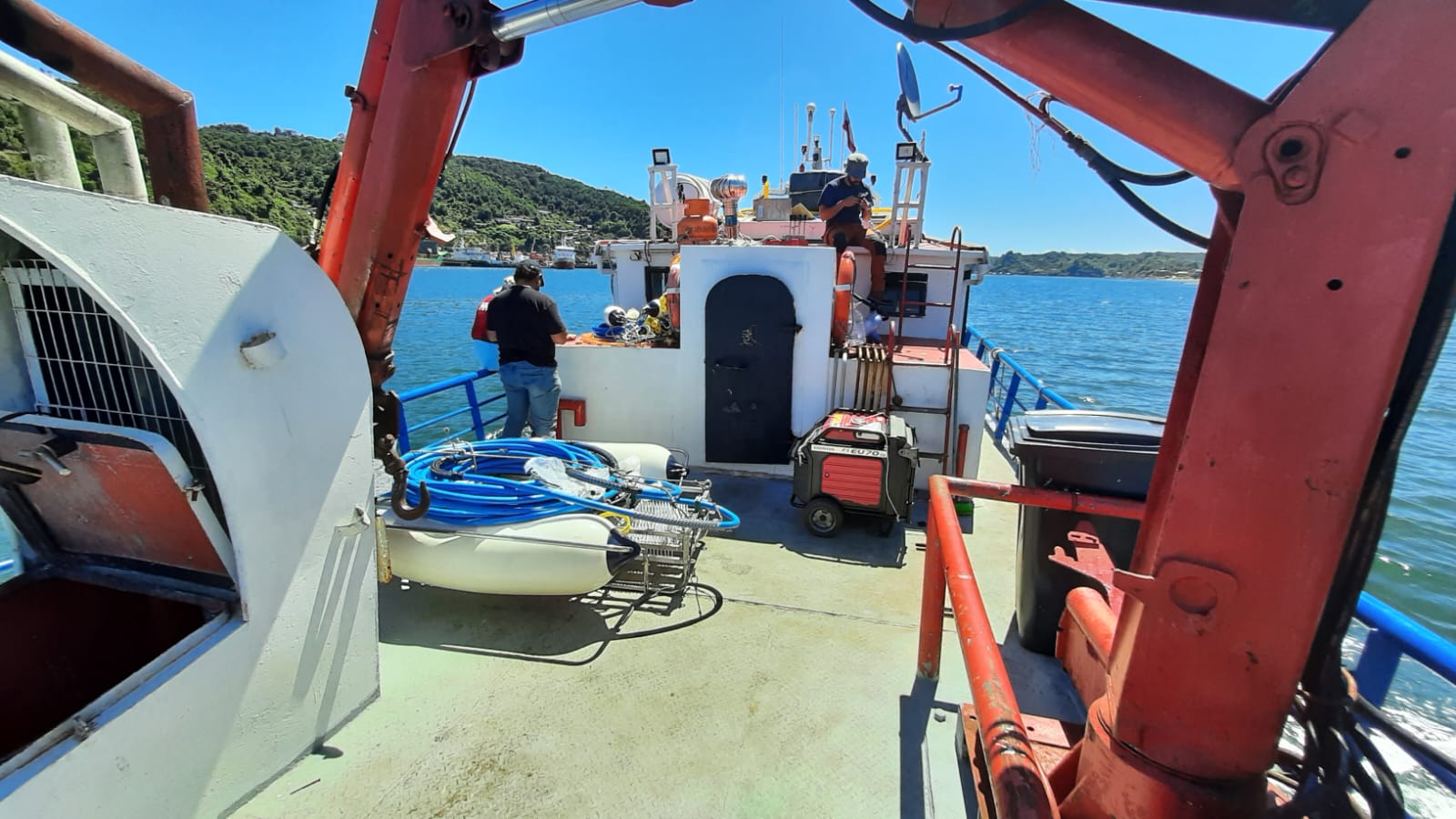
Launches, developments and improvements
The members of our design team always have their eyes on the next innovation; continuously seeking new ways to address the needs of our clients and improve functionality in order to keep them one step ahead in their research. These include:
- The release of our 7 element omni-directional transceiver for Nexus 2 and Pyxis, as part of our Easytrak USBL product range.
- The release of our Nexus 2 Lite with a 5 element omni-directional transceiver, complete with integral AHRS, depth sensor and temperature sensor.
- The release of REL-1529P and PAM-3515, to operate with our 1500 series release beacons.
- An improvement to our Nexus 2 operating system, with user interface for Windows 10 embedded.
- An update to our MiniPod wireless protocol and receiver software in order to allow the latest RTCM corrections to be received by MiniPods.
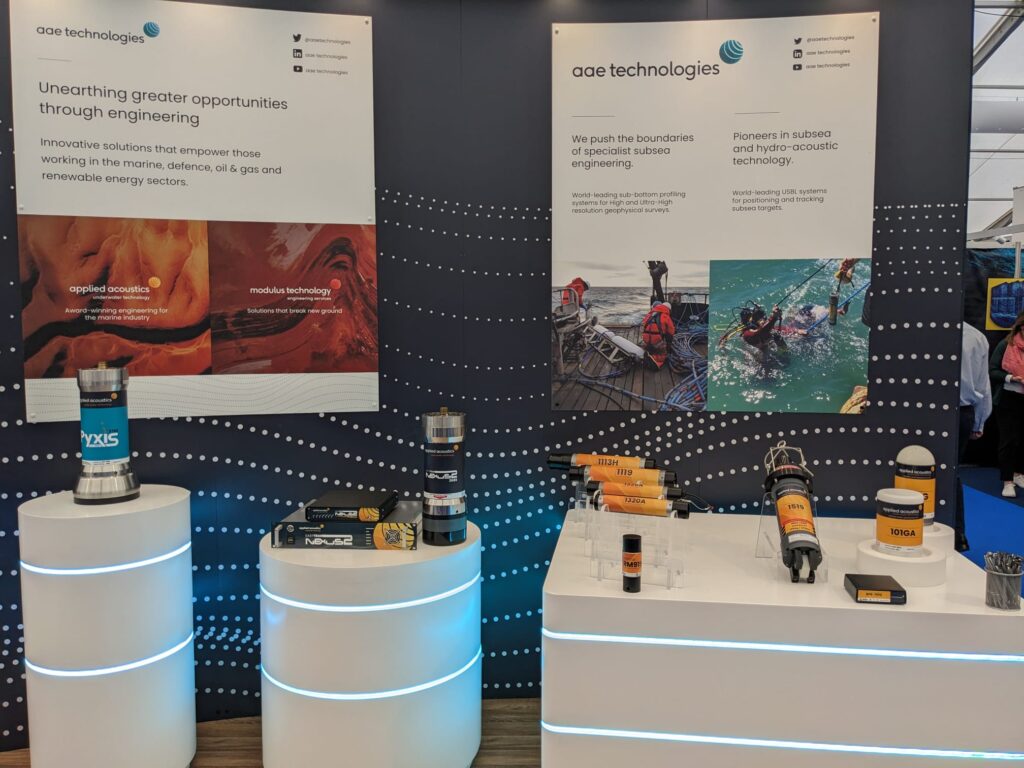
Team news
There’s been plenty to celebrate within the aae team this year, from new joiners to milestones for long standing members. Here’s a glimpse into what we’ve been up to:
Pam Chapman celebrates 15 years
After joining back in 2008, Pam Chapman celebrated the substantial milestone of her 15-year anniversary with aae. As Group Office Administrator, Pam is one of the longest-standing members at aae and a hugely valued member of the team. Have a read of her blog to learn more about how her role has evolved over the years and what she enjoys most about working with us!
Ashleigh Mingay runs the London Marathon
aae’s Operations Co-ordinator, Ashleigh Mingay, laced up her boots back in April to complete the incredible achievement of running the London Marathon. After surpassing her fundraising goal of £2000, Ashleigh was able to make an incredible donation to the charity Mind, in honour of her own journey with mental health and the support she’s received over the years.
New faces within the team
2023 saw us celebrate the team members who have been with us for years, as well as a few fresh faces who are just beginning their journey with aae.
This year, we welcomed Tomasz Prudlack as QC Inspector, Nicole Eman as Office Administrator, and Phillip Boyne as Electronics Test Technician. They’ve all been brilliant additions to the team, and we can’t wait to see what they achieve as their careers unfold with us. Check out their new starter introductions to learn more about them.
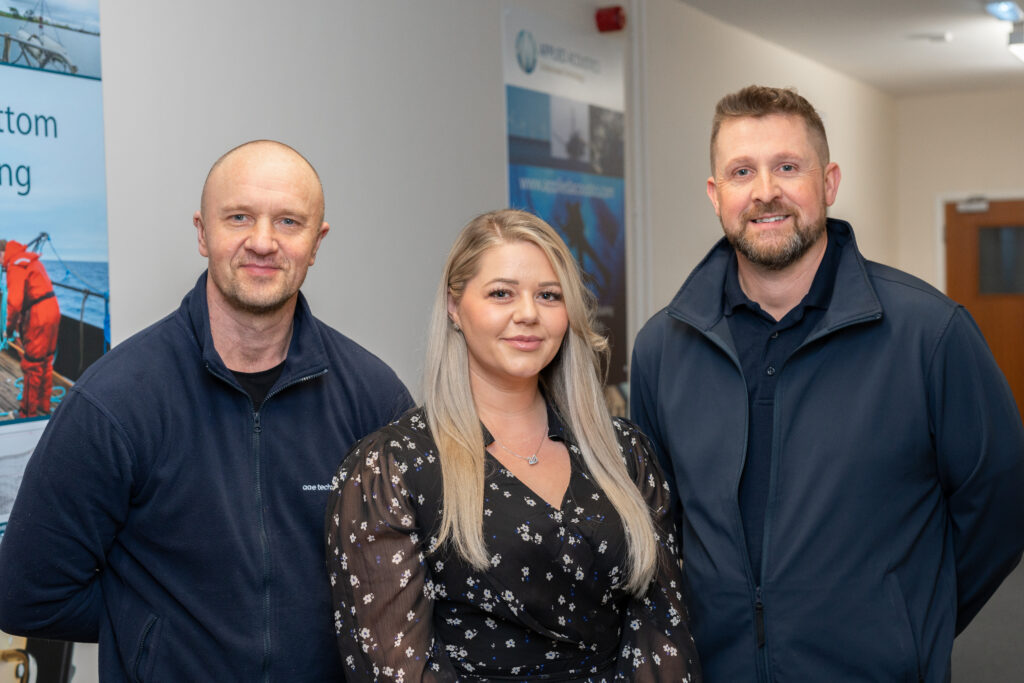
Coming soon
We have a number of exciting launches across our product lines in 2024, as well as an exciting new office update for the aae team.
The MiniPod family is growing
A new member will be joining the MiniPod family, with the exciting addition of the MiniPod 201G. The MiniPod 200 series offers all the features of our popular MiniPod 101G series, but with additional data accuracy and greater performance in harsh offshore environments. Key features include:
- Robust GNSS receiver with integrated antenna
- Multi-band L1 + L2 + L5 receiver
- RTK Moving Base and Rover Operation
- Multi-constellation of positioning satellites
- External Sensor Integration
- Submersible, 50m rated
- Wide area corrections or external RTCM
- Assembly shock rated to 75G for field endurance in harsh conditions
- Worldwide RF remote wireless data options
Stay tuned for more details to be revealed soon!
Upgrades for the team at aae HQ
The aae team is looking forward to a snazzy office upgrade in the new year, which will include a mezzanine floor for new stock, ultimately increasing capacity for production and storage, as well as a greener energy supply with solar panels being added to the roof of our head office in Great Yarmouth, UK.
We’re really excited about how this new space will help us to grow as a business – and we’ll share some photos with you as soon as it’s ready!
A happy New Year from us all
We’re all looking forward to taking a well-earned break as the year comes to a close, but we can’t wait to get back out on the road and continue supporting our clients in 2024.
We’ll share our events calendar within the next few weeks so that we can meet as many of you as possible if you’re headed to any of these. Be sure to keep up with all of our movements and new releases over the next year – we can’t wait to share what’s to come.
For now, we’d like to wish you a restful Christmas period and a happy, healthy New Year on behalf of everyone at aae. See you in 2024!
We have been developing MiniPods at applied acoustics for many years. Our MiniPod range is unique in its ability to deliver precise positioning, utilising our global navigation satellite systems (GNSS), ensuring that you can still operate in the challenging environment of the splash zone.
We offer a range of MiniPods that can be suitable for your projects, but it’s important that you know which MiniPod is right for your project specifications.
101G
The 101G MiniPod is a ruggedised GNSS receiver that is rated to survive up to 50m submersion underwater. The 101G is our base model which the MiniPod family is built upon and the most popular product in the range. The 101G can provide accurate surface positioning down to 1cm with RTK option, the internal electronic assembly is fully shock-mounted to ensure operation in tough environments giving confidence in the reliable position. Positional data is available wirelessly up to ranges of 2000m or can be cabled supporting various formats.
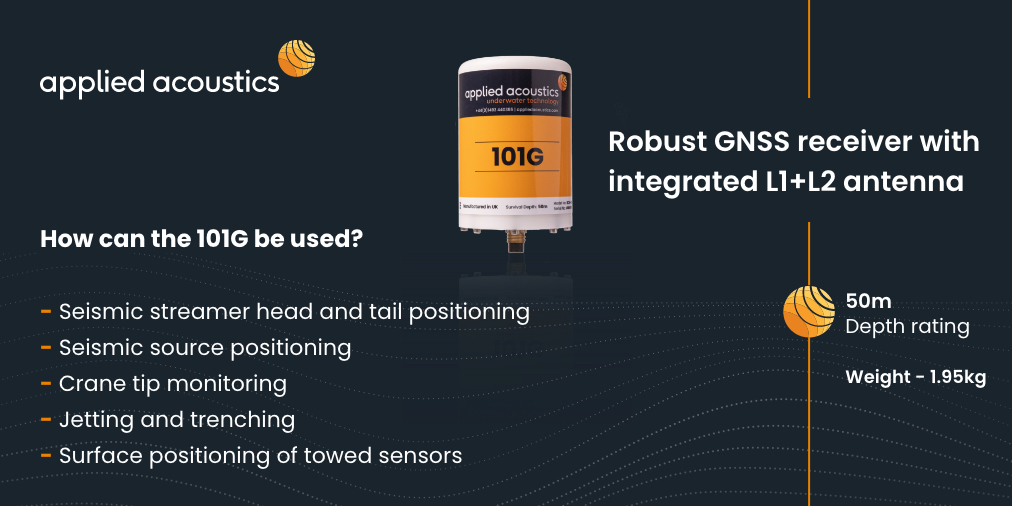
Housing
Small, lightweight, 50m rated the 101G MiniPod is designed to be compact weighing only 2kg and standing 170mm high with a diameter of only 115mm.
GNSS receiver and integrated antenna
The integrated high gain antenna and GNSS receiver allows for the MiniPod to be connected to power without a need for any other connected external antenna, providing positioning data within 60 seconds of start-up.
Worldwide wireless data
The integrated wireless RF module operates on the ISM 2.4GHz frequency band conforming to IEEE 802.15.4 to transmit MiniPod positional data back to the vessel up to 800m range as standard. The link is bi-directional allowing the vessel hardware to transmit RTCM corrections to the MiniPod to enhance positional accuracy.
Optional standalone correction service
For enhanced positioning accuracy where RTCM corrections can’t be sent wirelessly, the MiniPod has the ability to use the Atlas correction service which is a subscription-based satellite service to give positional accuracy to 10cm.
Typical Applications
The 101G MiniPod is an ideal solution for seismic positioning, becoming the industry standard for precise surface positioning; its lightweight and ruggedised build allows it to be mounted by a simple pole, giving precise seismic source, head and tail buoy positioning in real-time, enhancing the data acquisition and reducing errors from more traditional techniques, such as layback.
Crane Tip Monitoring
The MiniPod is placed at the tip of the crane for precise position of the crane tip, this is regularly used for cable laying vessels to ensure cables, protective mats and other associated equipment is placed in the correct location.
The 101G MiniPod can also be used for positioning of transition or shallow water subsea vehicles and towed sensors, where positioning is a requirement but the environment doesn’t allow for underwater USBL positioning to operate. The 101G is unique in that it is submersible to 50m water depth, allowing positional data to be acquired when the vehicle or towed sensor breaks the water’s surface and an underwater positioning system will fail to operate. Its quick acquisition time and warm/hot start functionality allows for uninterrupted positional data reducing delays and downtime.
Top Tips
- Elevate your MiniPod to ensure the best reception of satellite signals, avoiding surface reflections from the sea surface or masking from structures.
- Ensure the antenna logo faces towards the vessel; this is where the directional antenna for the RF is mounted internally; it is also denoted by a cut-out in the base of the MiniPod.
- Where possible, position the MiniPod as close as possible to the centre of rotation so the accuracy of position is less affected by movement.
- Always make sure that the latest firmware updates are installed onto the GNSS receiver and the MiniPod for the best operational performance.
- Regularly clean the top of the MiniPod with a mild detergent and warm water, this will ensure the best reception of satellite signals.
103G
The 103G is the next size up in the MiniPod family, the chassis of the 103G is strengthened to allow operations to 1000m water depth. The 103G retains the same operational characteristics of the 101G.
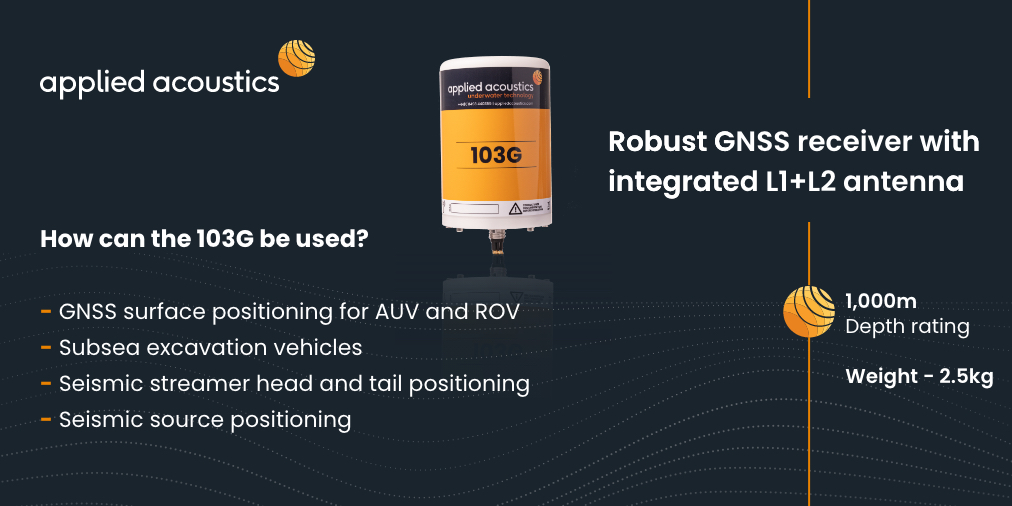
Housing
The 103G measures 218mm x Ø125mm and weighs 2.5kg. The lightweight construction of the 103G MiniPod is rated to 1000m submersion, making it ideal for surface positioning of subsea vehicles and towed sensors that are deployed to depths deeper than 50m, such as magnetometers or cable trenchers. The deeper rating housing also makes the 103G more suited to AUVs and ROVs that descend to depths further than 50m but less than 1,000m. Upon surfacing of a vehicle, the 103G MiniPod can lock on and start providing positional data within 60 seconds. This can help to relocate the AUV / ROV to return to operations or back to the vessel.
106G
The 106G has the highest depth rating of the MiniPod family. The lightweight titanium chassis with a glass radome allows the 106G MiniPod to survive ocean depths to 6000m. The 106G is a cabled surface positioning GNSS receiver, designed to complement standard subsea positioning beacons.

Housing
Toughened glass and titanium housing allows this MiniPod to survive deepwater operations to 6000m. Its strong shock-mounted construction makes this an ideal solution for operations such as trenching and UXO crawlers.
Battery Power
The onboard battery provides 4 hours of operation without power, which is ideal for deep water transition zone operations, trenching and construction; its rugged shockproof design allows for positional data to be cabled back to the vessel, ensuring the vehicle is on the correct entry path prior to the underwater positioning system taking over.
The 106G is also ideal for deepwater vehicle surface positioning for vehicle recovery, whether manned or unmanned vehicles the 106G can provide an accurate location within 60 seconds of surfacing or under 30 seconds if running warm, which means acquiring a position fix prior to going subsea.
107GS
The 107GS MiniPod is different to the other MiniPods in the range. The 107GS is a shock-mounted, ruggedised and submersible satellite transceiver with a combined GNSS receiver. The primary application is asset recovery and tracking at the sea surface. Instead of RF wireless to relay position back to the vessel or shoreline, the 107GS utilises satellite communications, meaning the asset can be tracked from anywhere in the world.
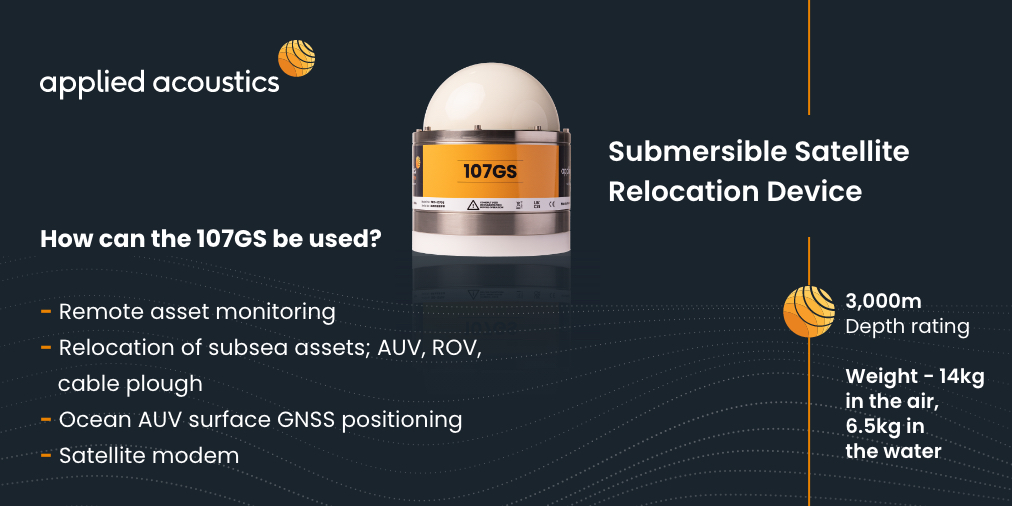
Automatic On/Off function
The 107GS has a factory set sensor to switch the unit on at <15psi, this ensures that the unit is not wasting energy when submerged, maintaining battery life for maximum operation.
Global Remote Tracking
Position data and data transfer can be sent from anywhere in the world using the Inmarsat Isatdata Pro service. This is a two-way data service that can send 6400 bytes of data and receive 10,000 bytes.
Housing
The housing is made from a titanium outer body, acetyl protective guard and toughened glass radome. The internal components are shock-mounted to ensure operation in rugged harsh environments. The 107GS MiniPod weighs 14kg in air and has an outer diameter of 203mm with a length of 285mm.
The 107GS MiniPod is the perfect solution for remote asset monitoring of larger deepwater vehicles. The worldwide satellite location allows for location data to be received easily through a subscription-based service and viewed in multiple locations at any time, making it simple to keep track of assets and aid in the recovery of assets.
If you would like to know more about our MiniPods or other products that can support with your next project, get in touch with our team today.
